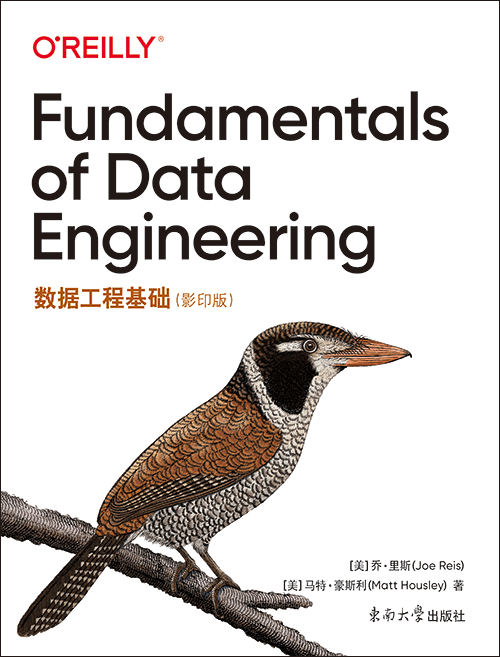数据工程基础(影印版)
出版时间:2023年03月
页数:422
“数据世界已经演变了有一段时间。首先是设计师,然后是数据库管理员,接着是首席信息官和数据架构师。本书标志着该行业演变和成熟的下一步。对那些忠于自己职业和事业的人来说,这是一本必读之书。”
——Bill Inmon
数据仓库的创建人
“本书很好地介绍了数据移动、处理和操作。我强烈将它推荐给任何想要快速掌握数据工程或分析的读者,或者想要填补理解上的空白的现有从业者。”
——Jordan Tigani
MotherDuck 创始人兼首席执行官,展开全部内容介绍
——Bill Inmon
数据仓库的创建人
“本书很好地介绍了数据移动、处理和操作。我强烈将它推荐给任何想要快速掌握数据工程或分析的读者,或者想要填补理解上的空白的现有从业者。”
——Jordan Tigani
MotherDuck 创始人兼首席执行官,展开全部内容介绍
- Preface
- Part I. Foundation and Building Blocks
- 1. Data Engineering Described
- What Is Data Engineering?
- Data Engineering Skills and Activities
- Data Engineers Inside an Organization
- Conclusion
- Additional Resources
- 2. The Data Engineering Lifecycle
- What Is the Data Engineering Lifecycle?
- Major Undercurrents Across the Data Engineering Lifecycle
- Conclusion
- Additional Resources
- 3. Designing Good Data Architecture
- What Is Data Architecture?
- Principles of Good Data Architecture
- Major Architecture Concepts
- Examples and Types of Data Architecture
- Who’s Involved with Designing a Data Architecture?
- Conclusion
- Additional Resources
- 4. Choosing Technologies Across the Data Engineering Lifecycle
- Team Size and Capabilities
- Speed to Market
- Interoperability
- Cost Optimization and Business Value
- Today Versus the Future: Immutable Versus Transitory Technologies
- Location
- Build Versus Buy
- Monolith Versus Modular
- Serverless Versus Servers
- Optimization, Performance, and the Benchmark Wars
- Undercurrents and Their Impacts on Choosing Technologies
- Conclusion
- Additional Resources
- Part II. The Data Engineering Lifecycle in Depth
- 5. Data Generation in Source Systems
- Sources of Data: How Is Data Created?
- Source Systems: Main Ideas
- Source System Practical Details
- Whom You’ll Work With
- Undercurrents and Their Impact on Source Systems
- Conclusion
- Additional Resources
- 6. Storage
- Raw Ingredients of Data Storage
- Data Storage Systems
- Data Engineering Storage Abstractions
- Big Ideas and Trends in Storage
- Whom You’ll Work With
- Undercurrents
- Conclusion
- Additional Resources
- 7. Ingestion
- What Is Data Ingestion?
- Key Engineering Considerations for the Ingestion Phase
- Batch Ingestion Considerations
- Message and Stream Ingestion Considerations
- Ways to Ingest Data
- Whom You’ll Work With
- Undercurrents
- Conclusion
- Additional Resources
- 8. Queries, Modeling, and Transformation
- Queries
- Data Modeling
- Transformations
- Whom You’ll Work With
- Undercurrents
- Conclusion
- Additional Resources
- 9. Serving Data for Analytics, Machine Learning, and Reverse ETL
- General Considerations for Serving Data
- Analytics
- Machine Learning
- What a Data Engineer Should Know About ML
- Ways to Serve Data for Analytics and ML
- Reverse ETL
- Whom You’ll Work With
- Undercurrents
- Conclusion
- Additional Resources
- Part III. Security, Privacy, and the Future of Data Engineering
- 10. Security and Privacy
- People
- Processes
- Technology
- Conclusion
- Additional Resources
- 11. The Future of Data Engineering
- The Data Engineering Lifecycle Isn’t Going Away
- The Decline of Complexity and the Rise of Easy-to-Use Data Tools
- The Cloud-Scale Data OS and Improved Interoperability
- “Enterprisey” Data Engineering
- Titles and Responsibilities Will Morph...
- Moving Beyond the Modern Data Stack, Toward the Live Data Stack
- Conclusion
- A. Serialization and Compression Technical Details
- B. Cloud Networking
- Index
购买选项

